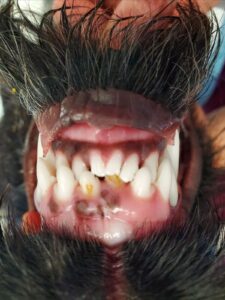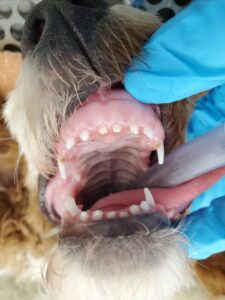
02 May Enamel Defects in Dogs
What is an enamel defect?
The outer layer of the crown of a tooth is enamel, the hardest substance in the body, even harder than bone. Enamel exists to protect the softer and more sensitive layers of tissue below it (dentin and pulp). While we perceive enamel as being white, it is actually somewhat translucent, and the white coloration comes from the underlying dentin. Very young animals have the whitest teeth, but sometimes even very young animals can have irregular or missing areas of enamel with areas of discoloration. The image below shows enamel defects on multiple teeth in a young dog.

What causes enamel defects?
Enamel defects are most commonly noticed in young dogs before a year of age, although the initiating cause likely occurred at a much earlier stage of development. In dogs, teeth start growing around day 25 after conception. When a puppy is born, they have two sets of teeth developing inside their jaws: deciduous (baby) and adult (permanent). Both types of teeth have enamel. Enamel production for each tooth is completed before the tooth erupts. If anything happens to disturb the complex process of enamel formation, it can result in enamel defects, dentin defects and/or malformed teeth. One example of this is the canine distemper virus which can attack the cells making enamel, resulting in enamel defects. This will result in enamel defects on multiple teeth. Infection with the distemper virus can be prevented by appropriate vaccination.
Trauma to a developing tooth bud can cause enamel defects to appear in just one area. Puppies like to play and aren’t very graceful. They can fall or be bitten on the face. Sometimes a puppy needs to have a deciduous tooth extracted. If this happens before the adult teeth erupt, it is possible for the veterinarian to accidentally damage the underlying adult tooth bud. The dog in the picture below only has enamel defects on two incisors.

Other potential causes of enamel defects include any infection, inflammation, toxin, or trauma that affects developing teeth. In some dogs, enamel defects may be genetic in origin.
Why don’t we notice enamel defects right away?
Enamel defects may be present in deciduous teeth but they can be hard to spot in a wiggly puppy. You can see them in the upper canines of the puppy in the picture below. When the adult teeth erupted in this dog, they did not have enamel defects.

Defects in the enamel expose the underlying dentin which, as mentioned earlier, is white. Over time, the exposed dentin will pick up stains and that that makes the enamel defects very obvious. Sometimes enamel isn’t missing when the adult tooth erupts, but either the enamel or the underlying dentin is abnormal, and the enamel starts to chip and wear off when the puppy is playing. In some dogs, the tooth surface looks irregular because the enamel is thinner than normal in some places.
How should enamel defects be treated?
Dogs with enamel defects should have an anesthetized exam with diagnostic imaging such as cone beam CT or dental radiographs. Some dogs with enamel defects may have other abnormalities such as abnormal root or dentin development, but this is less common. When dogs are young, the dentin layer is thin and should be protected with either a bonded sealant or composite restoration. These treatments can decrease sensitivity and protect the tooth pulp while it continues to produce more dentin from the inside. Enamel defects can make it easier for teeth to fracture or wear. You should avoid hard or abrasive toys such as antlers, bones and tennis balls. The irregular surface of the teeth can make it easier for plaque and tartar to accumulate, so regular home and professional dental care are important.
Dog Dentist in Fort Collins, Colorado
If you are seeing irregularities on the tooth surface of your pet, please give Animal Dental Care & Oral Surgery a call to schedule a consultation. We can help determine if you are seeing enamel defects, tooth fractures or tooth resorption and decide what treatment is needed. Enamel defects may not be pretty, but we can help ensure that your pet has a healthy, pain-free mouth!
Images used under creative commons license – commercial use (5/2/2024). Photo by Orlando Tapia on Unsplash



